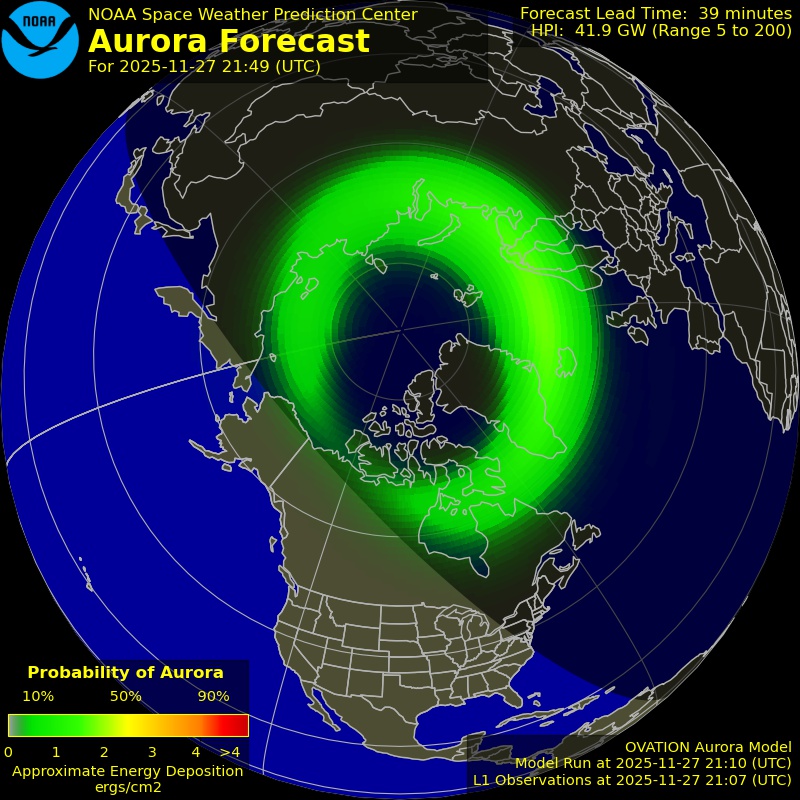Northern Lights Forecast for Minneapolis
Substorm
Substorm Phase: Quiet; Aurora Activity Score: 15/100
Ideal Conditions for Northern Lights in the United States:
Power: +60 Gw | Bz: -10 | Wind Speed: 400+ | Density: 4+ | Kp: 5+
Auroras have been known to show in the the state of Minnesota. The ideal conditions set above is for the Upper MidWest USA. Stronger data may be required for more southern cities.
Don’t Miss the Magic!
Stay ahead of the Northern Lights with real-time alerts. Subscribe now to receive a text or call whenever the aurora is active—so you never miss a moment of the show.
How to Use Our Aurora Forecast Tool for Minneapolis:
Embark on an extraordinary journey to witness the breathtaking Northern Lights in Minneapolis, Minnesota, with the help of our valuable Aurora Forecast tool. We collect live satellite data and present it in an easy-to-use dashboard, meticulously filtering out unnecessary noise. However, we understand that interpreting the data may be challenging. To make the most of this tool, follow our comprehensive “how-to” guide, offering detailed information on effectively utilizing the data.
Leveraging the Long-Range Forecast:
Enhance your aurora-chasing adventure in the Twin Cities by utilizing our long-range forecast feature. Plan your outings well in advance, allowing ample time to prepare for the mesmerizing spectacle of the Northern Lights. And that's not all – we take it a step further by providing minute-to-minute insights, ensuring a personalized and immersive experience under the captivating Northern Lights.
Best Places to See the Northern Lights in the Minneapolis:
While Minneapolis is a vibrant city, its urban lights can make it challenging to witness the Northern Lights within city limits. However, there are a few nearby spots where you can escape light pollution and have a chance to catch the auroras:
Sherburne National Wildlife Refuge: Located just northwest of Minneapolis, Sherburne Wildlife Refuge is a vast area with limited light pollution, providing an excellent opportunity to witness the Northern Lights in a natural and peaceful setting.
Open Horizon Locations: If you're in Minneapolis and the Northern Lights forecast looks promising, consider finding an area with a long open horizon, such as a field, where you can enjoy dark skies. The Northern Lights can appear and disappear quickly, so having an unobstructed view can improve your chances of witnessing this captivating phenomenon.
Further away from Minneapolis:
Jay Cooke State Park: Closer to Minneapolis, this state park offers easy accessibility and darker skies compared to the city, making it a potential spot for aurora sightings during periods of strong solar activity.
Tettegouche State Park: Located about a 3-hour drive from Minneapolis, this state park offers dark skies along the shores of Lake Superior, providing an opportunity to observe the Northern Lights in a serene setting.
Gooseberry Falls State Park: Also situated along the North Shore of Lake Superior, this park offers stunning views of the lake and a chance to see the auroras dancing above the cascading waterfalls.
Boundary Waters Canoe Area Wilderness (BWCAW): A few hours' drive from Minneapolis, BWCAW provides a remote and pristine environment, away from city lights, offering a secluded location to witness the Northern Lights over tranquil lakes and dense forests.
When Can You See the Northern Lights in Minneapolis?
Typically, the best time to catch a glimpse of the Northern Lights in Minneapolis is after dark, usually around 11:00 PM, and lasting until 3 AM the following morning. Nevertheless, during nights of exceptionally strong auroral activity, the Northern Lights may grace the skies much earlier, treating eager observers to an awe-inspiring display of nature's celestial wonder.
What is the best Time of Year for Aurora Borealis in the Minneapolis?
The best time of year to witness the Aurora Borealis (Northern Lights) in Minneapolis is typically during the fall, winter, and early spring months, from September to April. These months offer longer nights and darker skies, creating optimal conditions for observing the captivating dance of the Northern Lights. However, sightings are subject to solar activity and weather conditions, so keeping an eye on real-time aurora forecasts can help increase your chances of experiencing this mesmerizing natural phenomenon in the vicinity of Minneapolis.
How long do the Northern Lights usually last in Minneapolis?
The duration of the Northern Lights, scientifically known as the Aurora Borealis, can vary significantly. On average, a single display of the Northern Lights may last anywhere from a few minutes to several hours. However, during periods of heightened solar activity and favorable atmospheric conditions, the auroras can persist for several hours, painting the night sky with an enchanting and mesmerizing spectacle. The exact duration of the auroras depends on various factors, such as the intensity of solar storms, atmospheric conditions, and the overall strength of the aurora display.
What to Expect?
When witnessing the captivating Northern Lights in the Minneapolis, prepare to be dazzled by an array of colors dancing across the night sky. While the images of polar lights often depict vivid hues of green, pink, and purple, it's important to note that the naked eye might perceive a more subtle display. Expect to see beautiful white flashes or flickering, which might be mistaken for clouds. For a more vibrant and mesmerizing experience, capturing long exposures with a camera can reveal the true brilliance of the auroras. However, keep in mind that the colors you observe with your eyes may not perfectly match the striking tones seen in photographs. The enchanting dance of the Northern Lights is a unique and awe-inspiring spectacle that offers an unforgettable experience, leaving observers in absolute wonder of nature's beauty in the Minneapolis.
Aurora Oval
Northern Hemisphere

